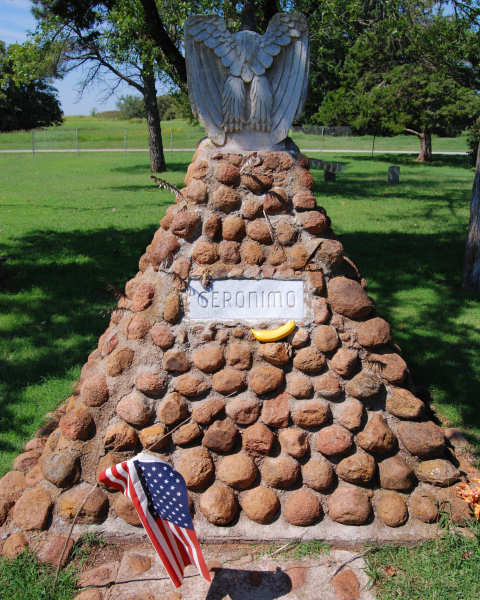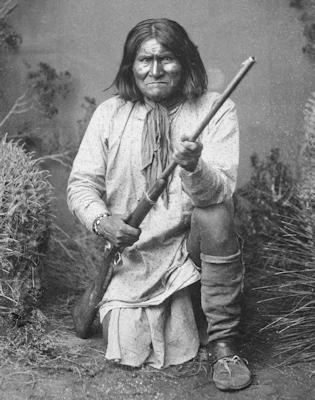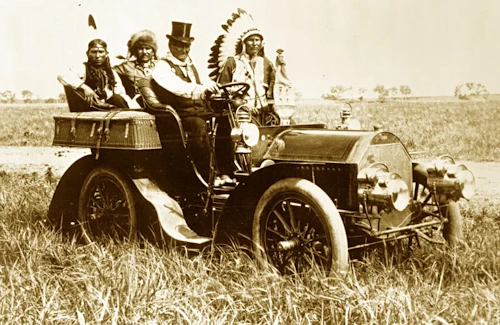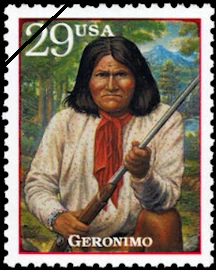
Geronimo
Apache Indian Cemetery
Ft. Sill, Oklahoma

Geronimo
Apache Indian Cemetery
Ft. Sill, Oklahoma
Geronimo (1829-1909) was a medicine man—a traditional healer and spiritual leader—and a skilled and daring warrior of one of the Apache tribes of the Southwest (present-day New Mexico, Arizona, and northern Mexico). Geronimo’s mother, wife, and three children were killed in an attack by the Mexican army, and he hated Mexicans with a passion the rest of his life, exacting retribution many times against both the army and civilians. The time period of roughly 1850-1886 was a time of more or less constant attacks, raids, and retaliation between the Apache and both the Mexican army and the U.S. army. The numerous series of conflicts became known as the Apache Wars. During the last ten years of these battles, Geronimo had several times been persuaded to surrender and move to a reservation, but three times had led a band of followers in breakouts to return to their old lands and lifestyle. Near the end of his freedom he led a small band of warriors, women, and children that for over a year continually evaded the American and Mexican armies of thousands of troops, in the process becoming the most famous Indian of that era. He eventually surrendered for the last time in 1886.
Some of the historically accurate and confirmed events of Geronimo’s life after surrender seem very strange to a modern American. When he was moved to Ft. Sill, Oklahoma, at train stops along the way tourists would pay him 25 cents for a button from his shirt or his hat as a memento. At an International Exposition in Omaha, Nebraska in 1898 he was a major attraction, becoming somewhat of a celebrity, and afterwards was in demand for public appearances. He attended other fairs, including the 1904 St. Louis World’s Fair dressed in his traditional Indian clothing, and posed for photographs with tourists. At President Theodore Roosevelt’s 1905 Inaugural Parade, he rode horseback down Pennsylvania Avenue with Indian chiefs who were wearing full headgear with painted faces. It’s reported that “...they created a sensation and brought the crowds to their feet along the parade route....”
Several years before he died, he told his life story to S. M. Barrett, the Superintendent of Education in Lawton, Oklahoma in a series of interviews. It was published as his autobiography, and there are several different editions in print today and widely available.
Just prior to World War II, U.S. Army paratroopers began a tradition of shouting “Geronimo!” as they leaped from airplanes, allegedly, so the story goes, to prove that they were fully conscious and in control of all their faculties, and unafraid of jumping.

A famous 1887 photograph of Geronimo with his rifle

Geronimo at the wheel of a 1905 Locomobile Model C, in Oklahoma, June 11, 1905
|
Geronimo’s Cadillac
Put Geronimo in jail down south Where he couldn’t look the gift horse in the mouth Sergeant, sergeant, don’t you feel Something wrong with your automobile Warden, warden, listen to me Be brave and set Geronimo free Governor, governor, isn’t it strange You never see a car on the Indian range Whoa boys, take me back I wanna ride in Geronimo’s Cadillac Whoa boys, take me back I wanna ride in Geronimo’s Cadillac Warden, warden, don’t you know The prisoners ain’t got no place to go They took old Geronimo by storm They took the feathers from his uniform Jesus told me and I believe it’s true The red men are in the sunset too They stole their land and they won’t give it back And they sent Geronimo a Cadillac Come on, I wanna go right back I wanna ride in Geronimo’s Cadillac Whoa boys, take me back I wanna ride in Geronimo’s Cadillac —Michael Murphey, 1972 |

U.S. postage stamp honoring
Geronimo, issued in 1994